We have been promoting a wide range of R&D activities systematically by coordinating between R&D sectors, including the R&D Directorates whose activities have been described in previous chapters and 12 R&D Centers located in various locations in Japan.
The R&D Directorates of JAEA have been promoting R&D for their respective purposes with the experimental equipment/facilities at each R&D Center. The R&D Centers have not only been operating and managing various types of equipment/facilities but have also been working on innovations and improvements for them, and in addition have themselves been developing experimental techniques, management techniques and equipment/facilities necessary for the various R&D projects of JAEA.
This chapter introduces the developments which have been made over recent years at each R&D center.
Tsuruga Head OfficeIn "MONJU", a "Function Confirmation Test" to confirm the performance and function of the facility which was modified to prevent sodium leakage, was completed in August, 2007, and a ?ePlant Confirmation Test' to check the entire function of the plant is being performed. In March, 2008, a report on the reevaluation of the seismic safety of "MONJU" was submitted to the national authority in light of the revised Regulatory Guide for Renewing Seismic Design. As a result of a false sodium leakage alarm which occurred in March, 2008, all of the sodium leakage detectors have been inspected. In "FUGEN," the spent fuel has been shipped out, and heavy water has been collected/shipped out however, after the decommissioning project was approved in February, 2008, the "Fugen Decommissioning Engineering Center" was reorganized to play a leading role in decommissioning projects. During the modification construction, the facilities and equipments with relatively low levels of radiation, and non-contaminated facilities and equipment are being dismantled. |
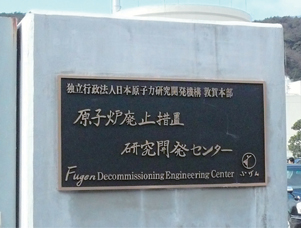 "Fugen Decommissioning Engineering Center" Reorganized February, 2008 |
Tokai Research and Development Center, Nuclear Science Research Institute (NSRI)In research reactor JRR-3, a high performance vessel is being developed to increase the intensity of a cold neutron beam. In JRR-4, the technology to increase the efficiency of dosimetry is being developed, in response to the demand for the increased usage of medical irradiation at the boron neutron capture therapy (BNCT). The technology for a Tandem Accelerator is being developed to achieve a higher performance of an ion source. Also, in the Facility of Radiation Standards, the facility for monoenergetic neutron calibration is being developed, to perform energetic experiments of neutron monitors. In addition, based on an external research fund which was started in 2007, irradiation technology of a 12 inch silicon ingot is being developed in JRR-4 and JRR-3. |
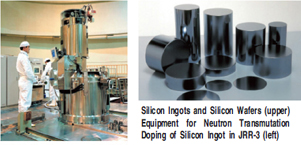 Semiconductors with uniform resistivity can be made by adding 31P evenly by nuclear transmutation of 31Si, and is widely used for thyristors to control high-voltages and high currents, CCD for video cameras and other devices. |
Tokai Research and Development Center, Nuclear Fuel Cycle Engineering LaboratoriesIn the Tokai Reprocessing Technology Development Center, a reprocessing test of spent MOX fuel was conducted by using about 3.1 t of fuel from "FUGEN". The research and development of the vitrification technology to decrease and stabilize the generation of waste which occurs in the tests was performed. In the Plutonium Fuel Development Center, a fuel production technology development test, and a physical characteristics measurement for the melting point and thermal conductivity of MOX pellet was performed for future FBR utilization. In April, 2008, based on the cooperation agreement between the U.S. Department of Energy (DOE) and JAEA, a cooperation agreement for the purpose of personnel training in the nuclear fuel cycle field was concluded at the Nuclear Fuel Cycle Engineering Laboratories and the Oarai R&D Center with the Idaho National Laboratory (INL). Hereafter, an assignment of personnel for training and education, and the exchange of information will be carried out based on this agreement. |
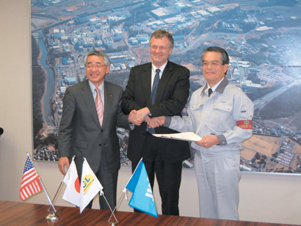
Conclusion of Cooperation Agreement Ceremony with INL
Shigeo Nomura (right) Director General, Nuclear Fuel Cycle Engineering Laboratories (JAEA) David J. Hill (center) Deputy Laboratory Director for Science & Technology, INL Hiroshi Hiroi (left) Director General, Oarai Research and Development Center (JAEA) |
J-PARC CenterIn Japan Proton Accelerator Research Complex (J-PARC), the building for three facilities for accelerators and a Material and Life Science experimental facility (MLF) were completed and trial operations are progressing for proton beam transportation. Particularly, in October, 2007, the acceleration of a beam by a Linac was successfully accelerated to 3 GeV by a 3-GeV synchrotron. Also, on May 22, 2008, the revolution control of an incidence beam was succeeded by a 50-GeV synchrotron, and on May 30, 2008, the generation of a neutron by a nuclear spallation reaction was successful in the MLF. The beam intensity will be increased further by the end of December, 2008, to start using MLF. |
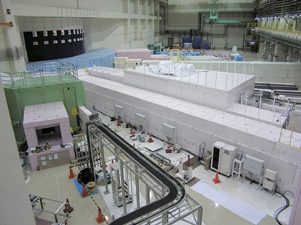 Neutron beam lines now under construction in MLF (J-PARC) Photo May 30, 2008 |
Oarai Research and Development CenterRegarding the R&D for the Fast Reactor Cycle Technology Development Project "FaCT", the irradiation tests for FBR high burn-up fuel and minor actinide containing fuel were performed in the experimental fast reactor "JOYO" and the post irradiation examination facilities. The experimental researches have been also carried out in the water and sodium test facilities. "JOYO" completed a highly advanced project (MK-III) which improved the irradiation capability by about four times more than in the past, and the results of the FBR cycle research using "JOYO" were accepted. As a result, "JOYO" received the "2008 Minister of Education, Culture, Sports, Science and Technology Award" in the science and technology field (Research Dept.). The refurbishment of the Japan Materials Testing Reactor (JMTR) was started for the restart in 2011. In May, 2007, the High Temperature Engineering Test Reactor (HTTR) achieved the first 30 days continuous operation with a nuclear reactor exit coolant temperature of 850 degrees C. Also the development of the hydrogen production technologies with an iodine-sulfur process and with a thermochemical-electrolysis hybrid cycle has progressed. |
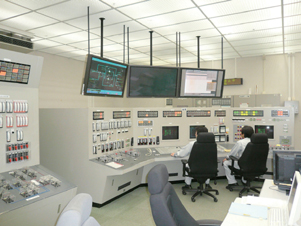 HTTR Central Control Room |
Naka Fusion InstituteNaka Fusion Institute in close cooperation with Fusion R&D Directorate, are aiming for the utilization of fusion energy. As well as fusion plasma research and fusion engineering research, the project to upgrade JT-60 is ongoing as a part of the Broader Approach Activities, to support and perform supplemental research for the International Thermonuclear Experimental Reactor (ITER)(to be built in France). In order to broadly introduce the forefront of nuclear fusion R&D, facility tours have been implemented often for local junior high school students and high school students from across the country (Super Science High Schools). Also, the facility is open to the public in October every year. |
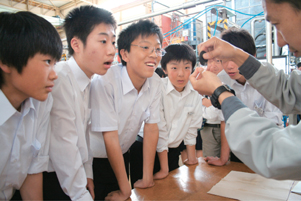 Junior high-school students marveling at the characteristics of a synthetic diamond, which is used for a plasma heating device at ITER |
Takasaki Advanced Radiation Research InstituteThe Takasaki Advanced Radiation Research Institute of JAEA opens the Takasaki Ion Accelerator for Advanced Radiation Application (TIARA), which consists of four ion accelerators, an electron accelerator, and gamma irradiation facilities, to be used by JAEA and any organization to perform R & D on biotechnology, new functional and environment-friendly materials, radiation effects of materials and quantum beam analysis. In 2007, the supply of a heavy ion micro beam of a several hundred MeV class was started in the experiment for the evaluation testing of radiation resistance of semiconductor and radiation effect study for living cells. The development of a high speed single ion hit technology at 10 hits per second or more is also progressing. |
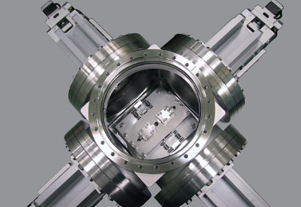 Divergence defining slit for formation of a heavy ion micro beam of a several hundred MeV class |
Kansai Photon Science InstituteIn the Kizu district, research on advanced lasers with a sub-petawatt laser oscillation output, and the oscillation of an X-ray laser with a output wavelength of about 10 nm have been performed and are progressing satisfactorily. In the research for laser utilization, the generation of semi-monochromatic electrons, high energy ion generation and basic research for medical applications are being researched. The new project, the creation of a "Photo Medical Industrial Valley", which had been proposed in the "Formation of creative base for innovations integrating frontier fields" program funded by the Special Coordination Funds for Promoting Science and Technology, commissioned by the Ministry of Education, Culture, Sports, Science and Technology (MEXT) of Japan, was commissioned in 2007. The Photo-Medical Research Center was established for this project in October, and activities for the creation of a "Photo Medical Industrial Valley" were started in collaboration with industries and universities in the Keihanna region, which extends over Kyoto, Osaka, and Nara prefectures, and is a new base of culture, science, and research in the 21st century. In the Harima district, various researches such as the treatment of spent-nuclear fuel using synchrotron radiation in SPring-8, and the superconductivity of a uranium compound are being researched. In addition, four dedicated beam-lines commonly used in the facility are available for use by any organization. |
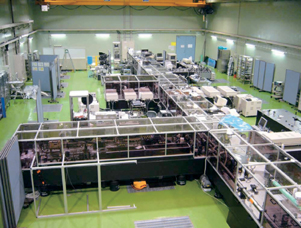 JAEA Kansai Advanced Relativistic Engineering LASER System (J-KAREN) |
Horonobe Underground Research CenterAs a part of the research and development program on the geological disposal of high-level radioactive waste, the Horonobe Underground Research Center, a division of the Japan Atomic Energy Agency, is implementing the Horonobe Underground Research Laboratory Project (Horonobe URL Project) with the aim of investigating sedimentary rock formations. Regarding the construction of URL in 2007, the derrick facilities used to excavate the shafts and pithead heater facilities for the entrances of tunnel were constructed, and the excavation of ventilation shafts reached 161 m, and 110 m for the East shaft. In addition, a pilot boring survey was conducted for the purpose of estimating the amount of groundwater that would flow into the tunnel during excavation, and to predict the point of flow. Regarding the above ground facilities, the construction of the Public Information House (Yume Chisoukan) of the Horonobe URL center was finished in May, and was opened in June 30. In December, the number of visitors reached 10,000. Regarding the construction of URL in 2008, the ventilation shaft, excavation of the east shaft and the drilling of a portion of the horizontal shaft continued to be constructed, and the waste water treatment facility will be extended. A pilot boring survey near the ventilation shaft, and joint researches with the other research institutes will also be continued. Regarding the above ground facilities, the construction of the International Communication House as the base of international exchange activities for domestic and international researchers will be started. |
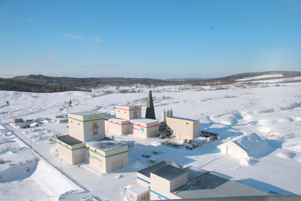 Winter view of the Horonobe Underground Research Laboratory from the viewing platform of the Public Information House |
Tono Geoscience Center (TGC)In the R&D to provide the scientific and technical basis for safe geological disposal of high-level radioactive waste, the R&D for investigation technology to characterize the deep geological environment mainly crystalline rock (Granite), a wide of range of engineering for deep underground application and the long term stability of the geological environment are being researched. In FY 2007, a drift was completed at GL-200m level, and the shaft has reached GL-231.2m in the construction of the Mizunami Underground Research Laboratory(MIU). This research is being performed in close collaboration with universities and scientific institutions, both in Japan and abroad. In order to promote a mutual understanding, TGC holds project explanation meetings for the local residents and municipalities, and openly accepts site tours of the facility. More than 3,000 visitors have visited MIU in the past year, and have experienced underground research first-hand. |
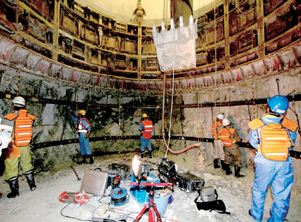 Geological mapping at the bottom of main shaft |
Ningyo-toge Environmental Engineering CenterThe Ningyo-toge Environmental Engineering Center has been developing a dry decontamination technology using an Iodine heptafluoride (IF7 ) gas as a part of the decontamination technology R&D for uranium enrichment facilities. In 2007, to promote the optimization of the decontamination processing condition, such as flux velocity, and flow rate, the decontamination time was reduced to more than half the time when compared to the start of operation. The preparation for the decontamination of a single type centrifugal separator cascade will continue to be promoted. In addition, the dismantling of a Refinement and Conversion facility was started and is in full scale, and is the first nuclear fuel facility in Japan. The facility dismantling data will be provided for the "Decommissioning Engineering System Database". The Ningyo-toge Mine continues to perform technology development for the mining complex |
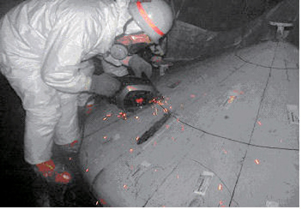 Decommissioning status of the Refinement and Conversion facility |
Aomori Research and Development CenterThe Aomori office in the Rokkasho area and the Mutsu office were unified and reorganized as the Aomori research and development center in April, 2007. In the Rokkasho area, the construction of research facilities for Broader Approach (BA) activities was started in March, 2008. The BA program is a joint implementation program between Europe and Japan which will be advanced in parallel with the ITER project which just started in France. In the Mutsu area, a radioactivity related database for a clearance evaluation system, a practical decommission method for the nuclear ship "Mutsu" related facilities, and an ultra low level measurement and related techniques about C-14 and I-129 by accelerator mass spectrometer (AMS) are being developed. "The 3rd symposium on marine environmental sciences" was held at Mutsu to disclose information to the local residents, and "The 1st JAEA Tandetron AMS utilization workshop" was held to exchange information between AMS users. |
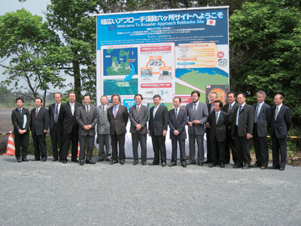 In order to propagate and to deepen the community's understanding of the Broader Approach activities, a billboard was put up on the site in June, 2007. |